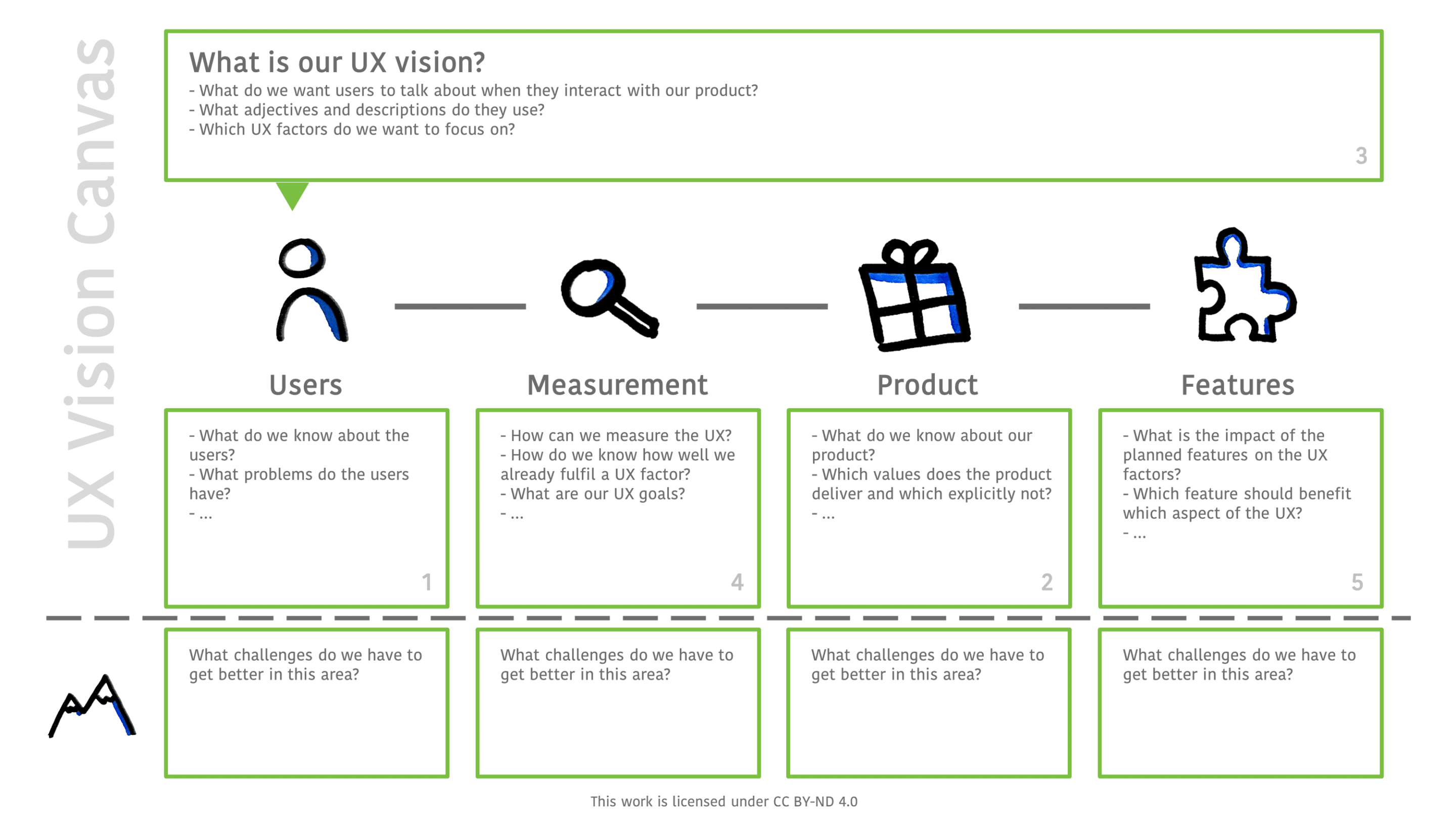What is the UX Vision Canvas?
The UX Vision Canvas helps to get a shared understanding of how the user experience of the product should ideally be perceived. In particular, it helps to proceed in a structured way as a group and not to forget the most important aspects. It is based on the idea that when developing a user experience, we focus on the user’s memories and the way they verbalise them.
The Canvas

Instructions

1. Step
Clarify what information or assumptions you already have about the people who will use your product. For example, share results from market research and user research and other artefacts that are already in use, such as personas or storyboards.

2. Step
Be clear about what your product is, what value it should deliver and, if necessary, what your product explicitly is not. This can include, but is not limited to, artefacts such as a feature list or a product backlog.

3. Step
Now it’s time to develop the actual UX vision. Take your time to do this. Everyone from the product team collects descriptions on cards that people ideally use to describe the user experience. One idea on one card and everyone collects on their own. This takes about 2-5 minutes. Then all the cards are put on the table and duplicates are removed. The cards are then packed into clusters by everyone together and the clusters are also named directly. The clusters are now the factors of the UX that can be targeted. In order to be able to focus, the group decides which 3-5 factors belong to the UX vision.

4. Step
After the important UX factors have been determined, it must be worked out how the factors can be measured. These can be key figures that are already collected or sometimes they still have to be recorded and calculated somehow. However, it is crucial that measurability is accompanied by quantifiability. UX goals can then be derived from this.

5. Step
Once the UX goals are clear, the planned features of the product need to be evaluated for their impact on the UX factors. Methods such as UX poker can be used to estimate the strength of the effect in the team.

In parallel to working out the five steps, you should write down what prevents you from knowing more about the four areas of Users, Measurments, Product and Features. Sometimes when you are working out your UX vision, you realise that you still know too little in certain areas. You can continue, but you should fix these blindspots as soon as possible, otherwise you run a high risk.
FAQ
Can I use the canvas for free?
Yes, that is the intention of the Canvas. It is meant to help all product teams. You are therefore free to use the canvas and also to distribute it.
How long does it take to complete the Canvas?
This depends very much on the work that has already been done. If a lot is already known about the users and the value of the product is clearly defined, a UX canvas can be completed within a few hours. The core of the canvas, the development of the UX vision, usually takes between 60-120 minutes, but this can vary greatly between different teams. However, it can often be observed that more time does not necessarily lead to better results.
Who should be involved in the development of the Canvas?
In the end, the canvas is only a vehicle to develop a shared mental model about the intended UX of the product. It is therefore advisable to involve those who make product decisions. However, the group should not be too large. The more people are involved, the longer the decision-making process will take.
Where can I get help when I need it?
Although new supporting resources are gradually being added here, it is understandable that you may need support at one point or another. In that case, please contact me at dominique.winter@designik.de.
Where to send ideas for improvement or feedback on the UX Vision Canvas?
The UX Vision Canvas is intended to help the community. That's why I'm happy to receive suggestions for further development. Feel free to contact me at dominique.winter@designik.de.
Download
Presentations
coming soon…
The scientific basis for the UX Vision Canvas
The development of a UX vision and the need for it due to many possible UX factors is not only the subject of the work of many practitioners but also part of scientific research. The following are important publications on the development of UX visions.
Winter, Dominique; Hausmann, Carolin; Hindersk, Andreas; Thomaschewski, Jörg (2023): Development of a Shared UX Vision Based on UX Factors Ascertained Through Attribution, International Journal of Interactive Multimedia and Artificial Intelligence, vol. 8, issue Regular Issue, no. 2, pp. 247-254. https://dx.doi.org/10.9781/ijimai.2023.04.001
Schrepp, Martin; Kollmorgen, Jessica; Meiners, Anna-Lena; Hinderks, Andreas; Winter, Dominique; Santoso, Harry B.; Thomaschewski, Jörg (2023): On the Importance of UX Quality Aspects for Different Product Categories, International Journal of Interactive Multimedia and Artificial Intelligence, (2023), http://dx.doi.org/10.9781/ijimai.2023.03.001
Hinderks, Andreas; Winter, Dominique; Mayo, Francisco José Domínguez; Escalona, María José; Thomaschewski, Jörg (2022): UX Poker: Estimating the Influence of User Stories on User Experience in Early Stage of Agile Development, International Journal of Interactive Multimedia and Artificial Intelligence, vol. 7, issue Regular Issue, no. 7, pp. 97-104. https://doi.org/10.9781/ijimai.2022.11.007
About me

After many years as a product manager, product owner and product leader, I am now a product coach. I help organisations improve their product development skills because I believe that it is our duty to develop the greatest possible value through products with the lifetime of our employees. To do this, I use my background as a studied organisational developer as well as my research around the UX competence of and in organisations.